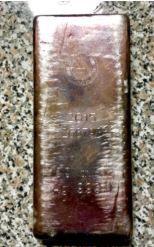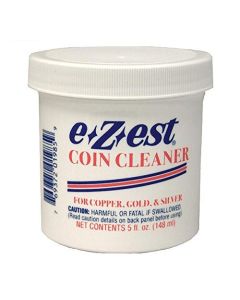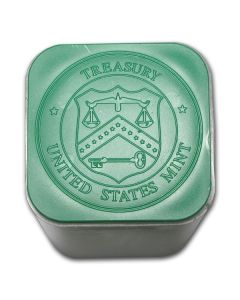Jumpt to: What is tarnish? | How does it happen? | Sterling Silver | Silver Jewelry | Tarnish and Silver Value | How to avoid it | How to clean it | FAQs
Silver is a beautiful metal that has been used for centuries to create jewelry, coins, and other decorative objects.
However, one of the most common concerns about silver is its tendency to tarnish over time. Many people wonder if silver jewelry and other silver objects will inevitably lose their luster and become dull and discolored.
In this article, we will explore the question of whether or not silver tarnishes and what you can do to prevent it from happening. We will discuss the science behind silver tarnishing, the factors that can accelerate or slow the process, and some tips and tricks for keeping your silver shiny and bright.
Key takeaways
- Understanding how tarnish is formed may help you avoid it;
- Pure silver takes longer to tarnish, but it is not immune;
- A tarnish layer does not affect silver value;
- There are several ways to clean tarnished silver and tips to avoid it..
What is Silver Tarnishing?
Tarnishing or toning is the process that makes your sparkly silver pieces look like dull metallic objects.
Several types of metal suffer from tarnishing: brass, platinum, titanium, gold-plated, and bronze, but it is usually associated with pure silver and sterling silver.
Some products tarnish quicker than others. For example, because of the finish on the American Silver Eagles, they tend to degrade slower than traditional bullion coins.

On the other hand, silver coins that are housed in PVC tubes may tarnish more quickly than the ones protected by a traditional plastic container. The PVC traps moisture and releases slightly acidic gasses, which can contribute to the toning/tarnishing of coins.
The good news is that tarnishing is a surface-level phenomenon and can be removed with proper cleaning and maintenance. However, it is important to take steps to prevent tarnishing in the first place, such as storing silver objects in airtight containers, using anti-tarnish products, and avoiding exposure to certain chemicals.
How does silver tarnishing happen?
Silver tarnishes due to a chemical reaction that occurs when it enters in contact with sulfur compounds in the air and on the skin. When exposed to air, silver reacts with hydrogen sulfide (H2S) gas to form silver sulfide (Ag2S) on the surface of the piece. This thin layer is dark and discolored, which can make the object look dull and tarnished.
In addition to air exposure, certain chemicals and substances can also accelerate the tarnishing process. These include things like perfumes, lotions, cleaning products, and even some types of food. When silver comes into contact with these substances, they can cause chemical reactions that speed up the formation of silver sulfide on the surface of the piece.
Pure silver is less prone to tarnish than sterling silver or other less pure alloys.
When silver is alloyed with other metals, the tarnishing process may happen quickly according to the chemical moisture they create. And the color of tarnish on silver changes as the tarnishing proceeds.
In the early stages of tarnishing, as the thickness of the layer over the silver surface grows, the color changes from yellow through red, brown to blue. Thicker layers promote darker colors, like black, which is silver sulfide's natural color.
That's why when designers want to give their silver an antique appearance, they'll oxidize the piece, exposing them to sulfur-containing compounds.
Does sterling silver tarnish?
Sterling Silver is a blend of metals resulting from an alloy of silver with other base metals. The composition comprises 92,5% pure silver, and the reminiscent percentage is typically copper, but other metals like nickel are possible.
Sterling silver is preferred among other alloys because they are more affordable, exhibits the same luster as pure silver, and are more solid to make delicate pieces last longer. However, the alloy with other metals hastens the tarnishing reaction.
A silver-copper alloy, for instance, makes sterling silver jewelry more durable. However, copper reacts with sulfur-containing gasses in the air to form a layer of the compound copper sulfide. As the piece tarnishes, it loses its bright white color and features a reddish hue, like red copper oxide.
How about silver jewelry?
Most silver jewelry is sterling silver. As pure silver is a soft metal and too malleable, jewelers usually alloy it with other metals to provide durability and resistance to manufacture sterling silver jewelry.
Silver plating is also common among jewelry options. Silver-plated items are pieces of another metal that has silver electroplated onto it.
As sterling silver and pure silver look the same, it may be challenging to know if your piece of jewelry is pure or alloyed. The easiest way to find out is to check hallmarks stamped on in small letters. Sterling silver is identified with a 925 or STER marking, while 99.9% fine silver displays 999 or FS markings.
In both cases, the metal alloyed to silver starts the tarnishing process.
Humid climate and highly polluted atmosphere influence tarnishing, as well as household bleach and strong chemicals.
As previously stated, products like perfume, hairspray, and deodorant can cause silver to tarnish faster. The products' chemical components react with hydrogen sulfide and copper, accelerating the process.
Fingerprints and body sweat from hands contain salts, oil, and moisture that transfer onto metal surfaces. That can lead to corrosion, especially on polished surfaces. Salt, or sodium chlorite, reacts with silver to form silver chloride, which is light-sensitive and darkens the piece over time.
Does tarnishing affect the silver value?
Tarnishing doesn't impact the value of items with lower premiums, such as silver rounds and silver bars.
These kinds of bullion products are typically valued by their weight and purity and not specifically by their condition and look. Regarding numismatic items and silver jewelry, tarnishing may affect the price.
Many coin collectors prefer coins to be in their natural state, even if they look "dull" compared to the cleaned coins. Collectors believe that tarnishing is just a part of the coin's history, and occasionally, with certain coins, tarnishing can actually increase the price of a coin.
It is recommended, therefore, that collectible coins are not cleaned but correctly stored instead.
Though, if you do intend to clean them, check out our article on how to clean silver coins.
Can silver tarnish be avoided?
Some easy tips can be followed to prevent silver tarnish or at least retard it.
A good beginning is to find proper places to keep them.
Silver items should be maintained in a cool, dry place, away from the sunlight. Silica gel, felt, or pieces of chalk can absorb moisture and humidity from the places where they are kept.
To avoid higher production of sulfides and prevent silver from tarnishing, keep your piece separate from others. Use proper containers to prevent undesirable contact and possible scratches. If not possible, storing silver in special container bags or jewelry boxes is advisable to avoid further tarnishing.

Handle your pieces carefully. Be sure to have your hands free from moisture, perfumes, or any other strong chemicals. Vinyl or cotton gloves are more appropriate to touch your silver pieces.
Before applying chemical moisture over your item’s surface, use a microfiber polishing cloth from local jeweler supply shops. They are soft cloth and may be less aggressive to your piece’s intricate details and remove the superficial thin layer.
If cleaning is necessary, get to know how to do it properly. To avoid damage, it is advisable to follow specialized instructions and use the proper materials.
How to clean tarnished silver?
Removing tarnish is not a complicated process. We have joined some simple tips you can do at home on how to clean silver bars and other items yourself.
1. Mild Soap
Cleaning silver with a solution of mild dishwashing soap and warm water may be the lesser aggressive attempt to clean your pieces safely.
2. Baking soda
If the solution above is insufficient, you can make a simple baking soda paste with water. You can gently scrub the paste on your object using a soft toothbrush or a non-abrasive cloth. Use a clean cloth to polish and finish your work.
3. Toothpaste
Toothpaste may be a little more aggressive cleaner. So choose one without additional whitening features or ingredients.
Use a soft toothbrush to scrub your silver gently and warm water to remove it. Remember to dry it with a clean cloth.
4. Lemon juice
Lemon juice is long used for cleaning purposes because of its efficient astringent properties. To clean pieces, lemon juice can be mixed with olive oil or hot water. Apply the mixture on your piece and use a lint-free cloth to obtain a smooth silver polish.
5. Ketchup
Tomato-based pastes, like ketchup, can work to recover silver because of the tomato’s acidic elements. Add your object into a bowl filled with ketchup and leave it for no more than 2 minutes. Remove the ketchup with paper towels and clean it until the tarnish disappears.
6. White Vinegar and baking soda
Use half cup of white vinegar with two tablespoons of baking soda to make a solution. Leave your silver to soak in the solution for some hours and wash it with cold water. Dry it with a clean polishing cloth.
7. Aluminum foil and baking soda
Lay your silver in a bowl and pour boiling water over it until submerged. Add a tablespoon of baking soda and a sheet of aluminum foil. Using a utensil, move the items together. The moisture should clean the pieces and shine your piece again.
8. Silver Polishers
If your piece is heavily tarnished and the domestic tips were insufficient to remove tarnish from your silver, you may feel more confident using proper silver polishers. They are more abrasive cleaners, which can remove the darker layer of tarnish. Following the instructions correctly, you can recover your item’s star-bright gleam.
Take a look at this tip below:
FAQs
Can you fix tarnished silver?
It is possible to remove tarnish from silver. And there are several minimal-cost ways to do it yourself and at home. Firstly, you should determine how tarnished your silver is and the type of piece you have. Both pure silver and sterling silver jewelry are soft and malleable. Because of that, it is essential to handle them carefully so as not to damage intrinsic details.
How do you stop silver from tarnishing?
Tarnishing results from a chemical reaction between silver sulfide and sulfur from the atmosphere. As long as silver is exposed to the air, tarnishing occurs. It is advisable to restrain this exposition. Pieces in Ziploc bags or airtight containers may offer useful storage. Contact with strong chemicals can accelerate tarnishing. So, when manipulating silver, have clean hands or use proper gloves.
Can silver tarnish permanently?
Tarnishing is not a permanent status. As long as you take good care of your items, you can avoid or retard tarnishing. Simple prevention acts, like proper storage and manipulation, can preserve silver. But, if the piece tarnishes, following simple tips, you can clean your silver at home without professional assistance. Even if the piece presents heavy tarnish, you can use silver polishers to remove tarnish and restore brightness.
How long does silver take to tarnish?
Silver can take two months or two years to tarnish. Silver tarnishes faster the longer it is exposed to the air, humidity, pollution, and chemical substances. Also, the speed in which silver tarnishes depends on how much sulfur-containing gases are in the air. But, it is essential to remember that it is not permanent. Tarnished silver is quickly recovered using the proper materials.
Is tarnishing silver a physical or chemical change?
It is a chemical change. When silver sulfide reacts to sulfur particles from the air, it forms a dark layer on the object’s surface, changing its appearance. If the piece has intricate details that demand brightness to be seen, the darkness may disturb its perception. But it does not affect the silver weight of the item. A 1 oz Silver Eagle, for example. Tarnished or shining bright, it weighs the same 1 oz.
What is silver tarnish called?
Silver tarnish can be called toning because of the darker tones that it provides to silver. But chemically speaking, specialists have called tarnishing oxidation, which means the loss of an electron and, consequently, a reddish or black aspect to the piece. When this effect is desirable, in jewelry manufacture, for example, the samples are exposed to sulfur components that oxidize the silver surface, accelerating tarnish and providing the piece with dark colors.
Why does silver tarnish when you don't wear it?
Silver reacts to air exposure. So, tarnishing naturally happens, especially if your silver is not correctly stored. Tarnish grows in humid and polluted places. Holding them in dry boxes or proper bags would help prevent it. Wearing silver pieces may also help preserve them because the skin’s natural oils can protect silver surfaces. However, body lotions, perfumes, or even sweat may have the opposite effect.
What is the difference between tarnish and rust?
Tarnishing is a chemical reaction primarily associated with silver but happens in several other metals, like brass, platinum, titanium, gold-plated, and bronze. The tarnish produces a thin layer over silver surfaces that darkens its natural color. Rust is an iron oxide, which means it happens only in iron. It has a reddish color that distinguishes it from tarnished metals. But like tarnish, rust can be removed with the proper material. Real silver doesn’t rust.




















